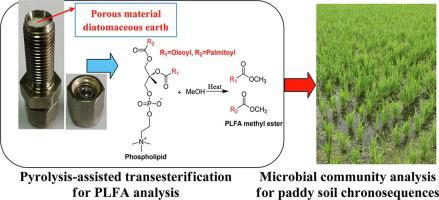Geoderma ( IF 6.1 ) Pub Date : 2021-10-01 , DOI: 10.1016/j.geoderma.2021.115504 Kai Cai 1, 2 , Yongpeng Zhao 1 , Zongjing Kang 1 , Rui Ma 1 , Alan L. Wright 3 , Xianjun Jiang 1

|
Phospholipid fatty acids (PLFAs) are widely used to assess soil microbial community and metabolic activity in various environmental samples. However, the transesterification of phospholipids into PLFAs still utilize homogeneous acid/alkaline catalyst, which may increase environment risk. This study developed and validated an accurate method for the determination of PLFAs in soil utilizing pyrolysis-assisted transesterification with diatomaceous earth. The thermolysis behavior of phospholipids, optimal pyrolysis conditions, tolerance against impurities, and recyclability of porous material were evaluated. Under optimal conditions, the transesterification can complete in only 8 min, with high impurity tolerance. The repeatability (relative standard deviation (RSD) between 2.59% and 12.12%), reproducibility (RSD between 5.22% and 16.22%), and linearity (r between 0.9259 and 0.9999) were excellent. This method was applied to analyze the PLFAs to evaluate microbial community of 1000-years paddy soil chronosequences and the relationships among soil chemical properties, enzyme activities and microbial community composition. Soil microbial biomass PLFAs increased significantly over time followed by slight fluctuation at 60–1000 years, but the ratios of soil fungal to bacterial and gram-positive to gram-negative PLFAs remained constant. In addition to soil total N and organic matter, soil enzyme activities related to N cycling metabolism also positively significantly influenced microbial communities. Overall, the developed PLFAs method using pyrolysis-assisted transesterification was environmentally friendly, efficient, accurate, stable, and suitable alternative to acid/alkaline transesterification of phospholipids.
中文翻译:

用于准确定量磷脂脂肪酸的热解辅助酯交换:在 1000 年稻田时间序列中微生物群落分析的应用
磷脂脂肪酸 (PLFA) 被广泛用于评估各种 环境 样品中的土壤微生物群落和代谢活动。然而,磷脂到 PLFA 的酯交换仍然使用均相酸/碱催化剂,这可能会增加环境风险。本研究开发 并验证了一种利用硅藻土热解辅助酯交换测定土壤中 PLFA 的准确方法。评价了磷脂的热解行为、最佳热解条件、对杂质的耐受性和多孔材料的可回收性。在最佳条件下,酯交换反应仅需8分钟即可完成,杂质耐受性高。重复性(相对标准偏差 (RSD) 在 2.59% 和 12.12% 之间)、再现性(RSD 在 5.22% 和 16.22% 之间)和线性(r0.9259 和 0.9999 之间)非常好。应用该方法分析PLFAs以评价1000年稻田土壤微生物群落序列以及土壤化学性质、酶活性和微生物群落组成之间的关系。土壤微生物生物量 PLFAs 随时间显着增加,随后在 60-1000 年间略有波动,但土壤真菌与细菌以及革兰氏阳性与革兰氏阴性 PLFA 的比率保持不变。除了土壤全氮和有机质外,与氮循环代谢相关的土壤酶活性也对微生物群落产生显着的积极影响。总体而言,开发的使用热解辅助酯交换的 PLFAs 方法环保、高效、准确、稳定、


























 京公网安备 11010802027423号
京公网安备 11010802027423号